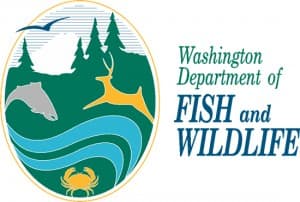Washington DFW: Can we De-ice our Roads Without Hurting Wildlife?
OutdoorHub 01.15.13

When Washington winter conditions include ice on our roads, driveways and sidewalks, de-icer applications become a safety necessity. But can we have safe human travel corridors without hurting wildlife attracted to salt and grit?
Wildlife biologists say the answer is “maybe” and it depends on what’s used where.
De-icers used by federal, state and local government road crews, as well as by private citizens at home and work, are mostly one of three types: 1) salt based (usually sodium chloride or common table salt, but also magnesium chloride, potassium chloride, and calcium chloride), 2) acetate based, or 3) sand.
Salt based de-icer has been used for over a century in North America and remains the most commonly used type because it is relatively inexpensive, available, and effective.
Large mammals, such as moose, elk, deer, bighorn sheep and mountain goats, are attracted to road salt, which sometimes becomes a factor in motor vehicle collisions with these big animals.
Perhaps less familiar to most is the attraction to salt by some birds.
“It’s all about the salt for winter finches,” said Washington Department of Fish and Wildlife (WDFW) biologist Chris Anderson.
“Winter” or Cardueline finches, of the Fringillidae family, including siskins, crossbills, grosbeaks, finches, goldfinches and redpolls, are seed-eaters that move south in winter when seed is scarce in their more northern breeding areas. They are known to love salt, with research showing they prefer sodium over other minerals, regardless of size. Salt is used by birds not only to fill a need associated with a vegetarian diet, but also as grit to aid in the grinding of food in their crops.
But research shows that birds ingesting relatively small numbers of road salt granules or small quantities of sodium chloride solutions, are at risk of sodium poisoning.
Normally the salt glands of birds excrete sodium and chloride to maintain proper chemical balance. But those glands can be compromised by lack of access to fresh, open water or exposure to certain pesticides or oil, and birds die of salt “poisoning” or toxicosis.
Cold weather that freezes areas of freshwater may force birds to use more saline waters that remain open because of the high salt content, including melted snow on roadways. Using salt water to dilute salt ingestion only makes the problem worse.
If birds aren’t killed by the road salt itself, they are killed when motor vehicles collide with them on those roads. In fact, some research indicates salt ingestion increases the vulnerability of birds to vehicle collisions by causing impairment – they are too weak or slow to avoid moving vehicles.
In one Canadian location – Mount Revelstoke Park — road mortality of siskins and other winter finches has been seen frequently enough over the last 25 years for the birds to be called “grille birds” by the locals, in reference to their propensity to be collected by the front end of moving vehicles.
WDFW biologist Ella Rowan, who monitors WDFW’s Wildlife Health hotline, says a call or two every year comes in about whole flocks of dead birds in a road, usually winter finches and perhaps where they were ingesting salt-based de-icer.
So what about the other de-icer types?
Acetate-based de-icers include Calcium Magnesium Acetate (CMA), Potassium Acetate, and Sodium Acetate. Research indicates CMA and potassium acetate do not attract animals and are harmless to them if ingested. Sodium acetate, however, may attract animals and contribute to roadkills.
Sand, of course, is natural, usually composed of crushed aggregate or pure river sand. It has been used to increase road or foot traffic traction at least as long as salt, but it obviously doesn’t have the actual “de-icing” effect of salt. Sand has no negative impact on wildlife, but in the amounts needed to keep roadways safe, it is more expensive.
Washington Department of Transportation (WDOT) wildlife biologist Kelly McAllister says applying affordable de-icers on our state’s roads is vital to the safety of winter travelers and we need to look for solutions that don’t compromise safety. Acetate-based de-icers are very expensive – usually in the range of four to five times as expensive as salt-based – they aren’t as effective, and they have high oxygen demand when they run off into road-adjacent waterways, he says.
“Providing salt sources for wildlife away from roads is something that is being tried,” McAllister said. “I think making open water more available to birds that are ingesting salt, to reduce the effects of toxicosis, is another part of the solution, but it’s obviously difficult to do on a large scale during freezing weather. We’re open to ideas and citizen help.”
WDFW biologists like Anderson and Rowan recommend that wildlife enthusiasts start at home. Use sand or acetate-based de-icers on sidewalks and driveways, or if you must use salt, use it very sparingly and keep it stored out of reach of wildlife. Maintain open water for birds during the winter, either by replenishing water at least daily or by using a safe bird bath heater element; keep bird baths clean to avoid spreading disease. Provide grit (sand or crushed egg shells) in a feeder to reduce the need for birds to go to roadsides.
And, as always, help birds stay healthy in general by maintaining year-round, sustainable habitat for wildlife in your own backyard. If you like watching winter birds close-up by providing supplemental feed, please keep feeders clean and use clean, dry feed only to avoid spreading disease.

